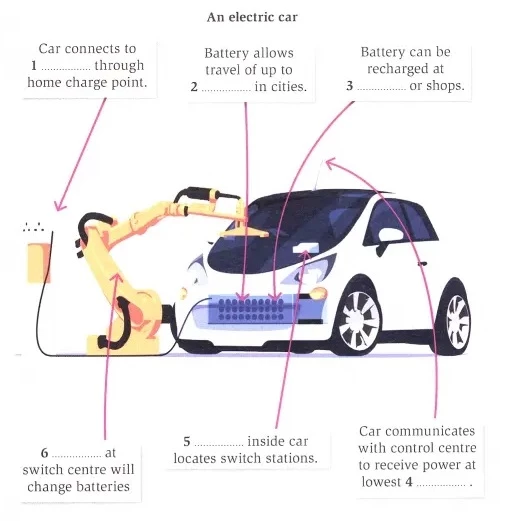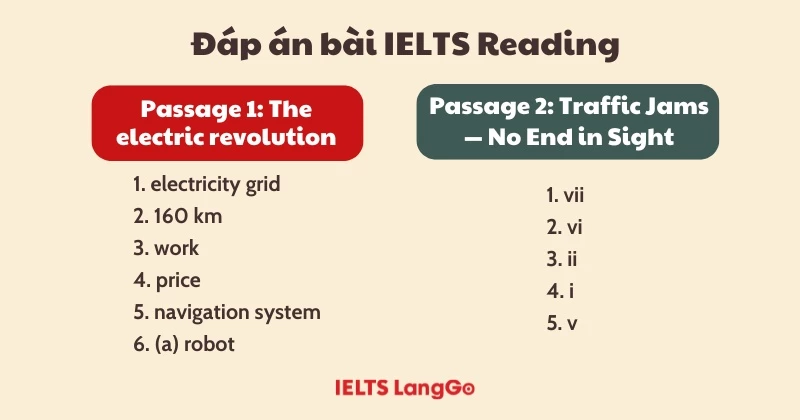


Cùng IELTS LangGo luyện tập IELTS Reading qua 2 bài đọc: The electric revolution và Traffic Jams — No End in Sight trong bài viết sau nhé!
| The electric revolution Your next car may be electric. We look at the technologies that will bring the revolution. The main reasons why electric cars are not more popular at present are their price and their relatively small range. Existing battery systems only allow electric cars to travel a distance of between 100 and 160 km. However, this distance may not be a problem for urban drivers. A recent Sydney study reported that 20 percent of journeys were 30 km or less, and recent data from the US suggests that ?? percent of trips taken there are 48 km or less. An innovative company called Better Place is aiming to make electric cars an option for all drivers. It wants to see existing vehicles replaced by electric vehicles which, it says, offer a number of benefits. Firstly, they can be powered by renewable energy which produces zero emissions. What is more, electric motors are more efficient and can convert more than 90 percent of power into movement, whereas the efficiency of diesel or petrol engines is less than 20 percent. To achieve its aim, Better Place plans to use technology which is already available. The plan is simple but revolutionary. It starts with the installation of a home charge point, and through this, the vehicle will be plugged into the electricity grid whenever it is in the garage, typically at night. In the morning, with a fully charged battery, the car is capable of as much as 160 km in urban motoring conditions. In addition to the home charge point, the battery can be topped up by charge points at work and at supermarkets. The battery is linked to a control centre by smart technology inside the vehicle. Better Place can then ensure that the car is charged with electricity from renewable sources at the cheapest price. For longer trips, a navigation system directs the driver to the nearest switch station, where the depleted battery can be replaced with a charged one by a robot within a couple of minutes. |
Questions 1-6
Complete the labels on the diagram below.
Choose NO MORE THAN TWO WORDS AND/OR A NUMBER from the passage for each answer.

| Traffic Jams — No End in Sight A.There are no easy answers to the problems of traffic congestion. Traffic congestion affects people throughout the world. Traffic jams cause smog in dozens of cities across both the developed and developing world. In the U.S., commuters spend an average of a full work week each year sitting in traffic, according to the Texas Transportation Institute. While alternative ways of getting around are available, most people still choose their cars because they are looking for convenience, comfort and privacy. B. The most promising technique for reducing city traffic is called congestion pricing, whereby cities charge a toll to enter certain parts of town at certain times of day. In theory, if the toll is high enough, some drivers will cancel their trips or go by bus or train. And in practice it seems to work: Singapore, London and Stockholm have reduced traffic and pollution in city centers thanks to congestion pricing. C. Another way to reduce rush hour traffic is for employers to implement flexitime, which lets employees travel to and from work at off-peak traffic times to avoid the rush hour. Those who have to travel during busy times can do their part by sharing cars. Employers can also allow more staff to telecommute (work from home) so as to keep more cars off the road altogether. D. Some urban planners still believe that the best way to ease traffic congestion is to build more roads, especially roads that can take drivers around or over crowded city streets. But such techniques do not really keep cars off the road; they only accommodate more of them. E. Other, more forward-thinking, planners know that more and more drivers and cars are taking to the roads every day, and they are unwilling to encourage more private automobiles when public transport is so much better both for people and the environment. For this reason, the American government has decided to spend some $7 billion on helping to increase capacity on public transport systems and upgrade them with more efficient technologies. But environmentalists complain that such funding is tiny compared with the $50 billion being spent on roads and bridges. |
Questions 1-5
Read the paragraphs one by one to choose the correct headings.
1. Paragraph A ……………
2. Paragraph B ……………
3. Paragraph C ……………
4. Paragraph D ……………
5. Paragraph E ……………
List of Headings
i A solution which is no solution
ii Changing working practices
iii Closing city centres to traffic
iv Making cars more environmentally friendly
v Not doing enough
vi Paying to get in
vii A global problem
Các bạn hãy thử tự đặt thời gian và làm bài thật nghiêm túc trước khi kiểm tra đáp án và tham khảo phần giải thích nhé.

1. electricity grid
=> Câu chứa đáp án: “It starts with the installation of a home charge point, and through this, the vehicle will be plugged into the electricity grid whenever it is in the garage, typically at night."
2. 160 km
=> Câu chứa đáp án: “In the morning, with a fully charged battery, the car is capable of as much as 160 km in urban motoring conditions."
3. work
=> Câu chứa đáp án: "In addition to the home charge point, the battery can be topped up by charge points at work and at supermarkets."
4. price
=> Câu chứa đáp án: "The battery is linked to a control centre by smart technology inside the vehicle. Better Place can then ensure that the car is charged with electricity from renewable sources at the cheapest price."
5. navigation system
=> Câu chứa đáp án: "For longer trips, a navigation system directs the driver to the nearest switch station."
6. (a) robot
=> Câu chứa đáp án: " … where the depleted battery can be replaced with a charged one by a robot within a couple of minutes."
1. vii
Giải thích: Trong câu 2 đoạn A, bạn có thể tìm thấy keyword: throughout the world = global (trong heading vii)
2. vi
Giải thích: Trong câu 1 đoạn B, bạn có thể tìm thấy các keywords: charge = paying và enter = get in (trong heading vi)
3. ii
Giải thích: Trong câu 1 đoạn C, bạn có thể tìm thấy keyword: flextime = working practices (trong heading ii)
4. i
Giải thích: Từ câu 2 đoạn D “such techniques do not really keep cars off the road; they only accommodate more of them” chúng ta có thể suy ra “đó không phải là một cách giải quyết” (tương đương với heading i)
5. v
Giải thích: Câu 2 đoạn E “such funding is tiny compared with the $50 billion being spent on roads and bridges” (số tiền tài trợ như vậy là rất nhỏ so với 50 tỷ đô la được chi cho đường sá và cầu cống) => chúng ta có thể suy ra là việc tài trợ đó là không đủ (tương đương heading vi)
Trên đây là đáp án và giải thích cho 2 bài Reading thuộc chủ đề Getting from A to B. Mong rằng những kiến thức trên đây sẽ hữu ích cho bạn trong quá trình ôn thi IELTS của mình.



ĐẶT LỊCH TƯ VẤN MIỄN PHÍ LỘ TRÌNH Săn ƯU ĐÃI lên tới 12.000.000đ